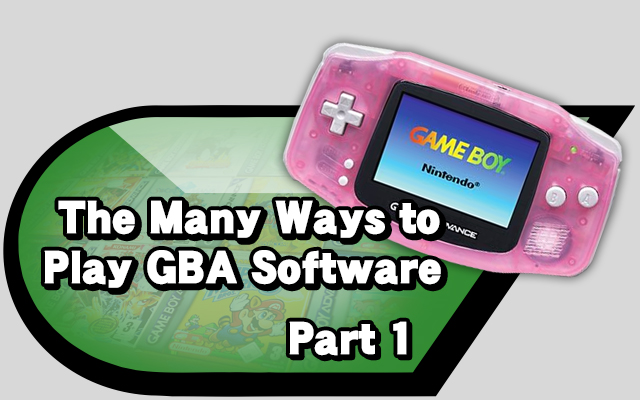

Bwaaaaaaaaaahhhhhhhhhhhaaaaaaa….ding.
Highly regarded as one of Nintendo’s greatest handhelds, the Game Boy Advance has a tremendous library of software that defines (still to this very day) what the system is truly capable of. Spanning across nearly 1,000 games, the GBA has a huge amount to offer for those interested in its vast catalog. These range from original games built from the ground up to remastered classics that were on consoles generations before.
To enjoy the wealth of GBA titles that are out there, there exist a wide array of options for playing these titles. Each option comes with their own Pros and Cons while some are highly sought after. Today, we’re going to take a look at the many options there are for play Game Boy Advance titles, and see which one might fit your preferences.
For simplicity sake, we don’t plan on mentioning any form of emulation (besides for VC and one gaming accessory.) There’s just simply too much forms of Emulation that reside out there that it wouldn’t be realistically plausible to cover every single option.
Anyways, without any further ado, here are the many options for playing Game Boy Advance software!
The Original Game Boy Advance
The original Game Boy Advance model released in 2001 was the first of many revisions the console would eventually face. Barring the additions of L and R buttons along with a wide-like format for the system, it was Nintendo’s first foray into 32-Bit Gaming with a handheld (unlike other things in the past.)
The Pros and Cons of the Original GBA include:
PROS
- 100% Compatiblity
- Link Cable Support
- Headphone Support
- GB/GBC Support
- Supports Physical Cartridges
- Readily Accessible to the Consumer
- 15 Hours of Battery Life
CONS
- No Rechargeable Battery (Needs 2 AA Batteries)
- No Backlit Screen
- Mono Speaker
While the original Game Boy Advance is really good with the basic necessities that any handheld console is known for (Headphones, Multiplayer, etc.), it does not comply with the standards that devices have now set in terms of user-accustomed features. While the timing of its release may have been at fault, the lack of of a Backlit screen and a rechargeable battery is severely disappointing in modern times. This means it’s going to cost you a lot for maintaining the console if you ever need batteries to power it on. The lack of a backlit screen may also prevent you from using your device in really dark areas or (in some cases) areas with bright light. Another minor con is the use of only mono sound in the speaker even though the games support stereo. This problem though can be remedied with the use of the Headphone Jack found on board with the system.
With those cons out of the way though, the original GBA is an excellent system for playing the extensive library of software as each original GBA is readily affordable. Combined with the fact that it has GB/GBC Compatibility, good battery life, a way to play with others, stereo sound with the use of headphones, support for the retail games you can buy today, and no compatibility issues with regular GBA titles; the original Game Boy Advance is good for those who are looking to get into GBA software quick and cheap with very little hassle.
The Game Boy Advance SP
Make sure to not flip out on the new design…
In 2003, Nintendo updated the original Game Boy Advance into a sleek clamshell design and called it the Game Boy Advance SP. It most notably is the first GBA model to officially include a front/backlight within its screen so you can finally play your GBA games in the dark.
For those who are in the market to get GBA SP, it’s worth noting that there are different versions of the model that exist. Specifically two variations known as the AGS-001 and the AGS-101. The only known major difference between these two is the type of screen they use. The AGS-001 has a frontlight screen while the AGS-101 has a backlit screen. The second revision to the GBA SP was made after the release of the Game Boy Micro in 2005 as (if one were to make assumptions) the cost of producing backlights, most likely, reduced significantly.
The Pros and Cons of the the GBA SP include:
PROS
- 100% Compatiblity
- Link Cable Support
- GB/GBC Support
- Supports Physical Cartridges
- Widely Available
- 7-8 Hour Battery Life with 3 Hour Charge time*
- Rechargeable Battery
- Frontlight Screen
- Small form factor with a Clamshell design
______________________________________________
- Backlight Screen (AGS-101 Exclusive)
CONS
- No Backlit Screen
- Mono Speaker
- Adapter Required to use Headphones
_____________________________________________
- Not as widely available (AGS-101 Exclusive)
While the GBA SP builds upon the foundation of the original Game Boy Advance, it does take a couple of steps back in terms of some user-accustomed features. The lack of a headphone jack built into the console is severely disappointing and seems like a downgrade from the previous model. There are adapters that can remedy this issue, but it gets rid of the overall convenience of having one built right into the handheld and forces the consumer to spend out of their pockets even more. Finally, the AGS-101 is simply not as widely available as it used to be, simply due to their screens being taken out by people so they can be modded into the original GBA.
Overall, even though the GBA SP does step back in terms of having no headphone jack on board, it is still a very good option for those who want to play GBA Software with a good front/backlit screen. It also supports every single game and accessory the GBA supports (contrary to popular belief, the GBA SP is compatible with the e-reader), uses a rechargeable battery, supports multiplayer, uses Physical Game Cartridges, supports GB/GBC games and has a clamshell design which allows for extreme portability. So with that in mind, the GBA SP is an extremely viable option for playing those old GBA classics.
The Game Boy Micro

IT’S SO TINY.
After the release of the AGS-001 GBA SP in 2003, Nintendo opted to go with a cheaper, more sleeker designed GBA known as the Game Boy Micro. This final revision of the handheld released in 2005, approximately one year after the release of the Nintendo DS. It came with the feature of customizing the front of the system through the use of faceplates. While this revision came with new features, it did not sell well and was relatively overshadowed by the Nintendo DS at the time making it a rare collector’s item to this day.
The Pros and Cons of the the GBA Micro include:
PROS
- Link Cable Support
- Supports Physical Cartridges
- Nearly 7-Hour Battery Life with 3 Hour Charge time*
- Rechargeable Battery
- Backlight Screen
- Small form factor (Extreme Portability)
- Customization with Faceplates
CONS
- Mono Speaker
- Not as widely available
- Adapter required for Link Cable
- No GB/GBC Support
- Not 100% Compatible
For being a budget model of the GBA, the Micro does a surprisingly good job of improving on what the previous iterations had. Just like every GBA model though, it does have its own list of setbacks. While it suffers it’s own variety of problems, it also inherits some from the SP models by having only one speaker on board even though these games are designed for stereo sound (although, again, it can be remedied through the use of the on board headphone jack) and it is not as widely available (similar to the AGS-101) due to it being overshadowed by the Nintendo DS. Other issues with this device is the requirement of an adapter (GBA Micro to GBA Micro multiplayer doesn’t need an adapter) in order to play with older model GBA’s (which causes some inconvenience to the consumer) and the lack of GB/GBC support (which older models did just fine.) The final issue is the lack of 100% compatibility compared to the older Game Boy models. This is due to it’s incompatibility with the e-reader as it cannot fit the form factor the GB Micro has. The only way to get it to work is to preform a mod to the shell of the e-reader which a casual consumer might no be willing to do.
Surprisingly, the Z80 processor necessary to run GB/GBC games still resides in the Game Boy Micro. The only reason support was taken out was due to the voltage switch needed to convert chips on the fly was removed. People have been able to get it working with the use of applications via a flashcart and some unused code found within the GBA BIOS.
Even with all those Cons however, the GBA Micro is a really good system for those who love customization and portability within their handhelds. Just like the SP models, it also has a rechargeable battery with a really good battery life. It can also, of course, support physical cartridges, has a backlit screen and can support multiplayer (of course with the right adapter to play with older model GBA’s.) Overall, the GBA Micro is a fairly good solution for those who want to get their GBA kick for gaming. While it might not be as readily available, it still contains some of the same amount of features compared to the rest of the GBA line.
*On the lowest brightness setting.
If you like this article, make sure to check out the rest of Source Gaming, as well as our Twitter, and let us know what you think!
Make sure to check out Part 2 which is coming soon!

- SG Roundtable: Open-Worlds or Multiple, Controlled, Choices (patreon request) - November 23, 2023
- SG Roundtable – Our favourite “Metroidvanias” (Patreon Request) - October 7, 2023
- SG Roundtable: Our favourite “Nintendo-likes” (Patreon Request) - August 15, 2023











Great memories with the GBA! Though I specifically had the SP. Thank goodness for the back lit screen… both the battery and the portability made it amazing for travel, too.
All the original games and SNES ported games really did make it an amazing system!
I don’t know why, but I always preferred AGS-001 the most. It’s accessibility and colors (I don’t do modding) just accelerate it further.
I would go for the gba micro, but price, link cable connectivity, and backwards compatibility issues just back it down.
I’m kinda weirded out by my GBA SP. It’ll change power when ever it wants, going from red to green whenever, this year being the first time it’s ever actually died. Even in my Pokemon Sapphire copy, on my second playthrough, easy Pokerus and Critical Hits. Both of them are legit. I guess they’ve seen some stuff.